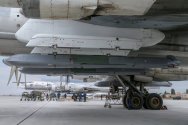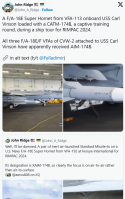More debate:Claims based on a Kh-101
View attachment 132155
You are using an out of date browser. It may not display this or other websites correctly.
You should upgrade or use an alternative browser.
You should upgrade or use an alternative browser.
The War in the Ukraine
- Thread starter SampanViking
- Start date
No one is talking about sending superbugs, USN needs them and doesn't have any pipeline to replace them. Or an extremely new(rare) missile desperately needed by pacific CSGs.answer to R-37?
View attachment 132160
Very broadly speaking - yes, but only in a sense that after two decades, US went into the LRAAM business again. But out of very acute necessity.
The drones that are being used against Russia and mainly against the Russian interior fly at speeds of 90-180 km/h, I don't think they are slow enough for the Yak-130, with the ability to intercept low-altitude aerial targets in low rated speeds, the aircraft is an alternative solution that may be promising.Drones are just too slow to be easily intercepted by a swept wing jet powered aircraft like the Yak-130.
The whole point of using the Yak-52, like Ukraine is doing, is that it can fly slower, and uses cheaper cannon or machine gun ammunition. The Yak-130 won't be able to stay on target easily, you will need to zoom in and out and it will be hard to target a small slow and low flying target with it. If you start using guided air to air missiles then the cost equation goes out of the window. An R-73 is way more expensive than most drones.
Maybe for the larger Ukrainian drones. But it neither cost effective nor viable against smaller ones.
Russia right now lacks its own serial production of propeller driven aircraft. So the whole idea is a non-starter.
The idea of light attack aircraft against UAVs seems like a much less costly solution than using fighters to perform the same function, even if it is to use the R-73 or any other missile, as it would be freeing the Su-30SM and other aircraft capable of more important tasks, saving useful life and preserving the fuselage and reducing maintenance requirements for these aircraft, which reduces the expenses necessary to cover these operations. It's a win-win.

The Yak-130 is sadly being neglected. For example, the Yak-130 could be the lead aircraft from which the UAV/UCAVs will be controlled. The co-pilot of the attack aircraft can take control of UAVs of the Orion and Okhotnik types, which will carry out reconnaissance, provide target designation, carry out air strikes and adjust missile and artillery fire.
The Yak-130 already has a helmet-mounted targeting system and a dual GPS/GLONASS receiver upgrading an inertial reference system for highly accurate navigation and precision targeting, it could still have multiple targeting pods, reconnaissance pods, EW pods and wingtip mounts for budget or other anti-aircraft missiles.
The Su-25 could carry multiple S-5, S-8, S-13 and also S-24 rocket pods ready to support ground troops, while the Yak-130 could carry standoff munitions, 9K121 Vikhr, Kh-25 (several including anti-radial) and Hermes, the latter being ideal. There could also be some Yak-130s with EW pods and reconnaissance pods, and some armed with just anti-aircraft missiles to protect the aircraft, so in theory the Yak-130 fires stand off munitions eliminating any threat to the Su-25 and, seconds then, the Su-25 descends to launch the barrage of rockets and strafe with its cannons.
Using the Yak-130 option in this way would free up the Su-25 or other aircraft for this role, so if, for example, Russia normally sent 4 Su-25s on a mission and two of the Su-25s carried standoff munitions while the others two carried rocket pods or if all four were armed with a mix of each, then using Yak-130's you would release two Su-25's, or in the case of 4 Su-25's with mixed armament you would now just have to take your chances 3 Su-25 instead of four approaching enemy fire. So, in my personal opinion, the Yak-130 could still have a place in front-line missions and be a cheap alternative, although not a replacement for CAS aircraft like the Su-25.
Or else Russia would have to consider the Yak-152. Start transferring the aircraft produced to DOSAAF hangars to effectively have a viable alternative in a war against UAVs launched on Russian territory.
The Russians want to make a single engine trainer aircraft to complement the Yak-130. Precisely because they think it is too expensive as a trainer aircraft. You are talking about a dual engine jet aircraft. There are also plenty of instances of people trying to fly the Yak-130 at low level and crashing the aircraft. It is just a plain bad idea.
The Yak-130 has a stall speed of 165 kph. Let that sink in.
The Yak-52 uses a single engine radial piston engine with a propeller and straight wing.
The Yak-52 has a stall speed of 85 kph. Totally different.
The Yak-130 has a stall speed of 165 kph. Let that sink in.
The Yak-52 uses a single engine radial piston engine with a propeller and straight wing.
The Yak-52 has a stall speed of 85 kph. Totally different.
Last edited:
What video is that image from? I've only seen one short video and can't see close to that amount of detail in the clip, there's only about 20 frames to look at and this image doesn't appear as one of them.
The trajectory doesn't look anything like an AA-missile, we had the infamous strike on day 3(?) of the war where a high rise in Kyiv was hit; that seemed like an obvious AA-missile, this one doesn't.
Oh, seems to be two different videos of the strike, with about 20 frames each. The one I had first seen was very low on detail.
The second one is the 10 second clip here:
Is there a higher quality around? Might also be edited/"enhanced" versions circulating around, garbage.
Not sure if this one is real?I think the PAC-3 is more unlikely due to the “wings”. The missile's tail and wings closely resemble the AIM-120. However, I certainly wouldn't rule it out as the sharpness of the image is insufficient to conclude anything.
Other:
View attachment 132150
Last edited:
The back fins do not really match with AIM120 which should be symmetrical.Oh, seems to be two different videos of the strike, with about 20 frames each. The one I had first seen was very low on detail.
The second one is the 10 second clip here:
Is there a higher quality around? Might also be edited/"enhanced" versions circulating around, garbage.
Not sure if this one is real?
Imho a PAC3 or Kh55 is more consistent with what the image looks like. But the damage pattern is a lot more consistent with air defense missile than land attack warhead. The latter would have collapsed the entire wing of the hospital, not caused massive shrapnel blast.
Either way, the debate doesn't actually mean too much. Whether it was a missing Patriot or a course knocked Kh55, it is still at its core a tragic incident due to air defense operations and having civilian structures way too close to military ones.
Missile that hit hospital turns out to be NASAMS, experts say. Farthest from an X-101 or any cruise missile in the world I have seen.
Three HIMARS units knocked out by Iskander in Kherson. Where's the idea of dispersing the units?
Ground based drone delivers a TM-62 land mine to a Ukrainian machine gun nest.
Pzh-2000 is knocked out in the Kharkhiv front. Ammunition cook-off this one is gone.
Russian MoD reveals Ukrainian chemical lab in Avdiivka, trying to make chemical agents.
A large Ukrainian supply convoy was tracked by UAV to a large ammo depot in the Sumy region. Here comes the Iskander with a cluster warhead. The ammunition depot goes kaput presumably packed with artillery shells and more, allegedly more than 20 different vehicles of different types, e.g. trucks and SUVs, and allegedly 65 personnel were killed.
Another Ukrainian crossing, possibly pontoon bridge, over the Oskol River is hit by a X-38ML missile.
A Ukrainian hanger with AFU equipment in Tykhe gets a cluster of FABs.
FAB hits a Ukrainian PVD in the Kharkhiv front.
Another recruitment attempt by the Ukrainian TCC.
Another knocked out Bradley in the Pokrovsk front makes it the 82nd visually confirmed loss.
AFU hits a village in Belgorod, killing three civilians.
LMUR hits a Ukrainian PVD inside a high rise building, knocked out several floors.
Showing off the Niu York tunnel that allowed a huge breakthrough by Russian forces.
Ukrainian pretends to be dead after seeing the 'shopping center' which is code for the TCC.
Enterprise of oligarch Akhmetov that produces components for the AFU, here destroyed in Krivoy Rog after a Russian missile attack.
Urals towing a Ukrainian BMP-2 hit by artillery from the Siberian Association.
Ukrainian SPG hit in the Volchansk direction.
Three HIMARS units knocked out by Iskander in Kherson. Where's the idea of dispersing the units?
Ground based drone delivers a TM-62 land mine to a Ukrainian machine gun nest.
Pzh-2000 is knocked out in the Kharkhiv front. Ammunition cook-off this one is gone.
Russian MoD reveals Ukrainian chemical lab in Avdiivka, trying to make chemical agents.
A large Ukrainian supply convoy was tracked by UAV to a large ammo depot in the Sumy region. Here comes the Iskander with a cluster warhead. The ammunition depot goes kaput presumably packed with artillery shells and more, allegedly more than 20 different vehicles of different types, e.g. trucks and SUVs, and allegedly 65 personnel were killed.
Another Ukrainian crossing, possibly pontoon bridge, over the Oskol River is hit by a X-38ML missile.
A Ukrainian hanger with AFU equipment in Tykhe gets a cluster of FABs.
FAB hits a Ukrainian PVD in the Kharkhiv front.
Another recruitment attempt by the Ukrainian TCC.
Another knocked out Bradley in the Pokrovsk front makes it the 82nd visually confirmed loss.
AFU hits a village in Belgorod, killing three civilians.
LMUR hits a Ukrainian PVD inside a high rise building, knocked out several floors.
Showing off the Niu York tunnel that allowed a huge breakthrough by Russian forces.
Ukrainian pretends to be dead after seeing the 'shopping center' which is code for the TCC.
Enterprise of oligarch Akhmetov that produces components for the AFU, here destroyed in Krivoy Rog after a Russian missile attack.
Urals towing a Ukrainian BMP-2 hit by artillery from the Siberian Association.
Ukrainian SPG hit in the Volchansk direction.
Last edited:
I do not know why people just assume that the missile in the video is the same that collapsed the annex building. We have no direct evidence of that. It could perfectly be that one missile collapsed the annex building and another spread shrapnel on the actual hospital.
It could perfectly have been both a cruise missile and am AMRAAM. I still think the missile in the video looks like an AMRAAM because of the fineness ratio. But the video quality is just so crap I cannot make a proper judgement on what kind of missile is displayed in it. As for the collapsed building that looks like way too much damage to be done by an AMRAAM. So that must have been a larger missile.
It could perfectly have been both a cruise missile and am AMRAAM. I still think the missile in the video looks like an AMRAAM because of the fineness ratio. But the video quality is just so crap I cannot make a proper judgement on what kind of missile is displayed in it. As for the collapsed building that looks like way too much damage to be done by an AMRAAM. So that must have been a larger missile.


